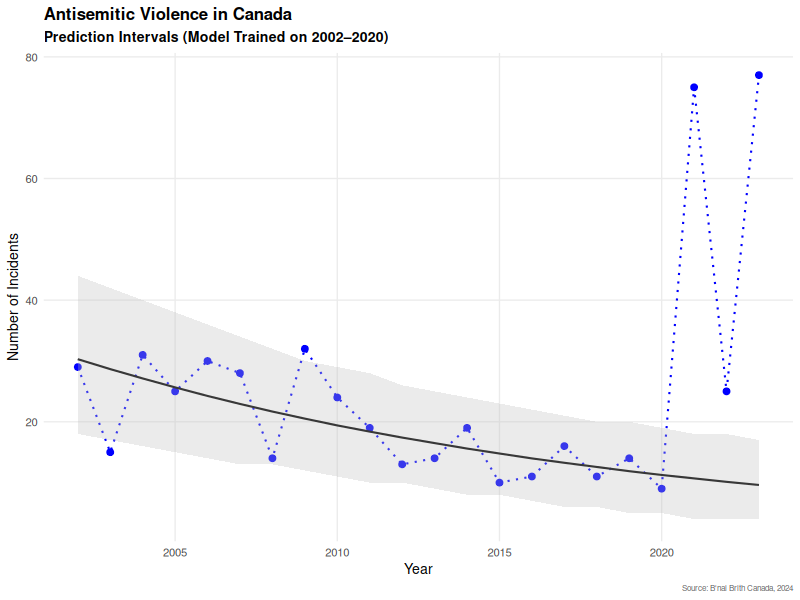Overview
In the past two decades, reported antisemitic violence in Canada has shifted in noteworthy ways. Data from B'nai Brith Canada show a generally decreasing trend until 2020. Beginning in 2021, however, these reports no longer followed the earlier downward path. This analysis explores how and why the trajectory changed, and what it may indicate for the Jewish community in Canada.
Data Source
The data for this study come from B'nai Brith Canada , which publishes annual counts of reported antisemitic incidents across the country. Our analysis focuses on incidents classified specifically as violent from 2002 to 2023.
Analytical Approach
To investigate these trends, we used a Poisson regression model. This approach is well-suited for count data, such as the number of reported incidents per year. We fit the model using data from 2002 through 2020, capturing the steady decrease in those early years.
Next, we used a bootstrap method to quantify the uncertainty in the model’s predictions:
- Resampling (2002–2020 data) allowed us to account for variability in the model’s estimates.
- Future predictions were then generated for the years 2021–2023 to see if actual incidents would follow or deviate from the historical trend.
These steps provide prediction intervals that help us determine whether recent observations are consistent with the prior pattern or signal a meaningful departure. The R code used for these analyses is available here: antisemitic-violence-canada-statistics.
Results
The figure below shows how actual incidents compare to model forecasts. The blue dotted line and dots represent the observed incidents up to 2023, while the black line shows the model’s projections based on the 2002–2020 trend. The gray band around the black line indicates the 95% prediction interval. Observed data points that lie above this band suggest a meaningful change in the post-2020 period.

Interpretation
From this chart, it appears that antisemitic violence declined steadily until 2020, hinting that incidents might gradually disappear. After 2021, however, the reported data diverge from that earlier downward path. This change raises important questions: what factors might explain the sudden shift in incidents?
Possible explanations include differences in social attitudes, such as the influence of immigrants from regions where antisemitism is more common, or global events that have reverberated locally. For example, disruptions during the COVID-19 pandemic or heightened conflicts in the Middle East may have intensified or reshaped antisemitic behavior within Canada.
Identifying the exact causes requires deeper investigation, including demographic analysis, assessments of media (and social media) influence, and exploration of both local and international dynamics. Additional contextual data would be helpful in clarifying whether these elevated incident counts reflect short-term fluctuations or a longer-lasting trend.
Conclusion
Although historical data suggested a progressive decline in antisemitic violence, the years following 2021 indicate a significant deviation from that path. These trends may signal the beginning of a new phase in antisemitic incidents, possibly driven by shifting sociopolitical and global factors.
These findings underscore the importance of continued monitoring and further research into the potential drivers behind this apparent change. Policymakers, community leaders, and researchers may wish to reevaluate their assumptions about antisemitic behavior in Canada and investigate underlying causes that could be influencing these outcomes.
